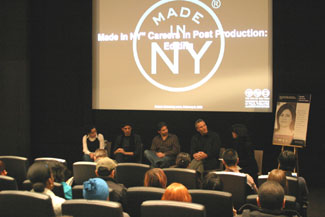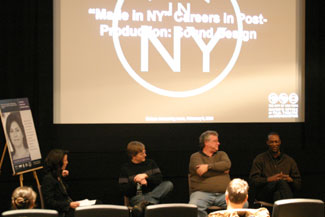
| |||
|
| |||
Local Editing and Sound Professionals Share Their Experiences at "Made in NY" Careers in Post-Production February 5, 2009 - At back-to-back panels presented by the Mayor’s Office of Film, Theatre and Broadcasting, New Yorkers were given the opportunity to hear first hand accounts from members of the City’s post-production community at “Made in NY” Careers in Post-Production. The panels, which took place at Deluxe New York, were moderated by Commissioner Katherine Oliver. Editing and Color Correction
Mike Jackman, the vice president and general manager of Deluxe New York as well as the production supervisor on Gangs of New York, The Aviator, and Eternal Sunshine of the Spotless Mind, explained that post-production really begins before the film is even shot. Decisions like what kind of cameras will be used, whether it will be film or digital, and then what kind of film is chosen can affect the entire post-production process. That process can take eight months to a year for a studio project and six months for an independent feature. “There’s 350,000 feet of film, and the production makes that 10,000 feet of film,” said Jackman. “They tell us what parts to cut. We digitize it, put in the timeline, color correct it, and convert it to another negative that gets used for the print.” When Jackie Tejada first started out, she was logging tapes during the day and working at a bar at night. She proved her dedication to the job by showing up an hour before anyone else did and staying late. After working on a number of television projects, Tejada was recently given the chance to be the first and only assistant editor on Cadillac Records. The work was challenging she said, but going to the premiere was “really satisfying.” Thomas Ostuni, an editor at Chinagraph NYC who recently worked on the MOFTB’s “Reel Jobs. Reel Proud. Real New Yorkers." PSA campaign, likened the editing process for commercials to putting together the pieces of a large puzzle. “You have a few thousand feet of footage and you have to turn it into a 30 or 60 second spot,” he said. “You’re constantly thinking on your feet, never knowing how’s it’s going to end.” Among the skills Ostuni recommended an editor should possess are paying close attention to detail, mastering the role of diplomat, being able to keep a cool head, and staying confident even when you don’t feel that way. As a colorist at Nice Shoes, a color correction studio in New York City, who’s worked on campaigns for Pizza Hut, Kohls and the MOFTB's PSAs, it’s Lenny Mastandrea’s job to make the commercial he’s working on look as good as possible by enhancing the color on screen. “I get to be creative and look at it from four or five different angles,” he said. “Sometimes color takes on a life of its own.” Color correction can even go so far as change the seasons depicted in a scene from spring to fall. Offering career advice to those assembled, Ostuni also emphasized the importance of diversifying your skill set. “If you have the ability to learn both Final Cut and Avid, do that,” he said because it could mean the difference between getting the job and not getting the job. Jackman noted how it’s the people who put everything into their work who are the ones to rise up. “People show up two hours before their shift [at Deluxe],” he said just so they can learn about other aspects of the post-production process. You also have to decide if you really want to do this because “you’ll have no life,” said Ostuni. “The minute you make plans, you’ll be working till 3 in the morning.” “Working long hours is not being taken advantage of,” added Jackman. “It’s an industry that, when you start, everyone expects you to work hard.” | |||
 | |||
Sound
“Sound is half the experience [when watching a film],” said Tom Fleischman, a four-time Academy Award nominee for his work on The Silence of the Lambs and Reds. It provides the audience with access to the story. As a sound re-recording mixer, Fleischman is responsible for putting together all the sounds that are created for a given project. “When I get the film, it’s in many pieces – dialogue tracks, replacement dialogue, soundtrack, Foley tracks,” he said. “I mix it together for the final print.” Supervising sound editor Ron Bochar explained how he gets involved with a film during either production or editing. He coordinates with the crew and works with producers on the budget and what they envision the sound should be. Bochar’s credits include “Made in NY” features Julie and Julia and Doubt as well as "Angels in America," for which he won an Emmy for Outstanding Sound-Mixing. Winston Philip, a sound designer and mixer who works in television and commercials, noted that with commercials, the deadlines are much shorter. A piano player since the age of five, Philip began as software engineer and accounting programmer before working on high profile recordings of Tina Turner, Lauren Hill and Chaka Khan. Philip is currently the principal mixer at Audio333; his present projects include the dialogue editing on the language translation on an “X-Men” cartoon. During the panel, he also emphasized the significance of networking by explaining how a chance meeting through a mutual friend led him to a new job. Both Bochar and Fleischman worked in Foley early in their career. “Foley,” explained Bochar, ”is all the little noises you hear in a movie, a pen dropping, feet stomping away.” After watching a scene over and over again, Foley artists recreate the sounds or attempt to enhance them. “I tripped a lot doing Foley,” remembered Bochar. “It’s a form of acting.” The panelists also emphasized just how important sound is to a film, TV, or commercial. “You’re watching a flat image,” said Bochar. “We can place you in the film.” “The next time you watch a movie and there’s a scene in a cemetery, listen for the crows,” said Fleischman. “They herald the dead.” | |||
 |

